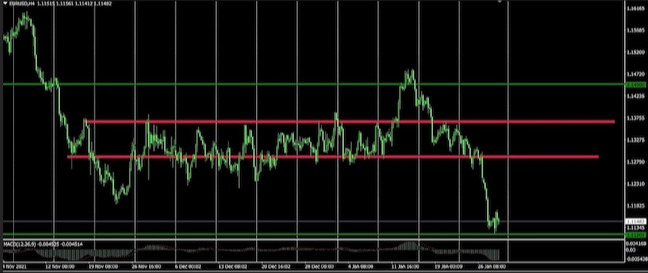The last week has been an interesting one for FX in terms of economic events, and there's more that traders should expect this week. We have the upcoming RBA Rate Statement and Cash rate, OPEC-JMMC Meetings, BOE Monetary Policy Summary, ECB Press Conference and NFP.
Last week, the USD ended on a positive note due to hawkish commentary from the Fed with Chair Powell saying that tightening could be more aggressive assuming that conditions are appropriate for doing so because "the economy is much stronger, and inflation is much higher." The implication is that they could do it sooner than they did the last time and perhaps faster.
Analysts at Nomura expect that the pandemic will have a temporary slowdown that could be reflected in next week's ISM surveys and potentially in NFP data. It's possible the pandemic's effects could still have a big impact on the economy until March, but then conditions could improve.
This week Fed members who are expected to make comments could give us clues about a potential rate hike in March. Many analysts expect a March rate raise by 50 basis points, and then other potential hikes in May, June, July and December.
“We forecast that the FOMC will raise its target range for FFR 125 bps between March and the end of the year," analysts from Wells Fargo said. "We continue to expect the Committee to raise rates 75 bps more over the course of 2023 with 25 bp rate hikes in the first, second and third quarters of the year.”
In Europe, nothing new is expected at the upcoming ECB meeting, but analysts previously warned that the situation could change if inflation continues to exceed expectations until the end of the year. But the likelihood of an ECB rate hike this year remains very small.
As for the BOE meeting, it seems like a 25 bps hike is almost priced in. However, one thing that could influence the GBP this week is the Sue Gray report and its potential political implications for PM Boris Johnson. Some speculate it could even lead to his resignation, but this remains to be seen.
For the energy markets, analysts from Nomura identified some key driving factors: Gas prices could continue to go up because of the tense situation between Russia and Ukraine with Russia appearing to supply less gas to Europe than at the same time last year. The oil prices could keep on rising as inventory and production declines in the US. The OPEC will meet this week and is expected to assess the market and decide on supplies for March.
In Australia news has been positive lately. Nomura analysts expect the RBA to lower the unemployment and inflation forecasts following the recent data. In terms of policy, the analysts are confident the Bank will announce the end of all QE bond buying at this meeting, as well as signal the start of the rate hike cycle. A 15 bps rate rise is expected in June and 25 bps in August and November.
Citi analysts anticipate an end to the RBA's QE program by mid-2022, but they also expect the economy in China to slow down. Since AUD/USD is correlated to CNY, if the CNY weakens, the AUD might be held back as well. "AUD can still perform reasonably strongly given terms of trade dynamics with longer term forecasts for base metals generally robust," Citi analysts said.
EUR/USD expectations
From a technical perspective, the EUR/USD looks good for selling opportunities on the H4 chart. After closing the week near the 1.1120 support, a correction is expected, and the next resistance is at 1.1295. If rejected, the pair could resume its downtrend and test the support at 1.1050. On the upside the main two levels of resistance are 1.1365 and 1.1440.
Taking into consideration the economic events that are expected this week, the more hawkish signals from Fed members and no change in ECB monetary policy, I expect EUR/USD to be bearish, but surprises can always happen. ING analysts noted that "EUR/USD will remain at the mercy of the repriced Fed tightening cycle" while Scotiabank expects inflation to recede in the latter part of the year and thinks the ECB will act with caution.

